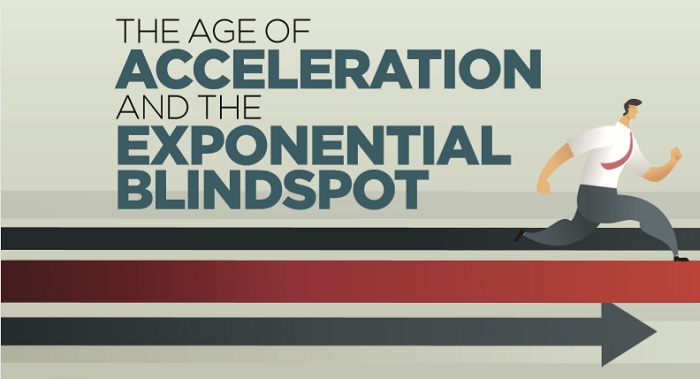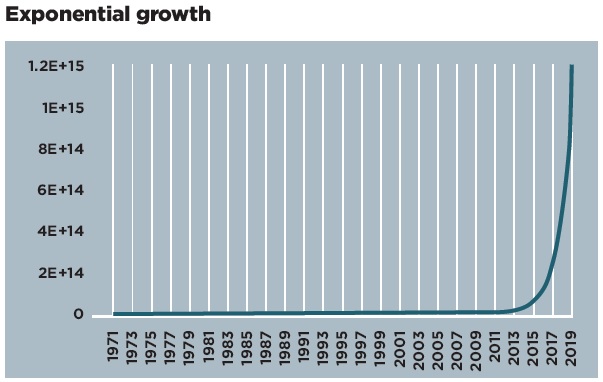Ray daSilva looks at the concept of exponential growth, how it affects all our lives and how it will continue to do so.

In his book Thank You For Being Late, Thomas Friedman notes the dramatic and relentless acceleration of change that started showing up in 2007 and talks about several key driving factors. If you examine any of his charts that track these factors, it will look similar to the chart below.
The pattern should look familiar. It applies to any of the following factors:
- Moore’s Law (the doubling of transistors on a single microchip);
- Amount of carbon dioxide in the atmosphere;
- Tropical forest loss;
- Ocean acidification;
- Population growth;
- Real GDP (Gross Domestic Product);
- Water use;
- Amount of data storage which can be purchased for $1.
Not all of the above factors double every year but their individual graphs look puzzlingly similar. They exhibit the same swift exponential climb from seemingly nowhere. What seems to be negligible growth takes off at some point and starts accelerating at such a high speed, it is startling.

To create this chart in Excel, I input the number 2 in 1971 and doubled it every year until the year 2020. The actual numbers are not important for this discussion, but the point of great and noticeable acceleration is.
In the chart, it does not look like much is happening between 1971 and 2015. That is not true. Things are actually doubling every year at a predictable pace. We just don’t notice it much. As humans, we are accustomed to and adapt fairly well to linear change. It is when growth hits the point of noticeable acceleration that we become uncomfortable. Change accelerating at a speed beyond our ability to understand and adapt is frighteningly unfamiliar.
Take road vehicles as an example. We started with the wheel that developed into carts pulled by people and animals; then we moved to steam-driven locomotives and later on gas-powered vehicles that then became electronic vehicles. With each milestone, we faced huge ethical, legal and practical dilemmas spurred by these technological advances. We adapted and our lives improved and prospered with every change.
Now, let’s go back to the chart. It is now 2020 and we have come to the point of noticeable hyper acceleration in the development of autonomous cars.
As with previous new inventions, we are once again faced with ethical, moral, legal and regulatory issues. If an autonomous car reaches an intersection where it is faced with three grim scenarios: 1. hitting two children that are playing ball; 2. running over an elderly person crossing the street; 3. crashing into a light post that would almost certainly kill its passenger; what should it do? We have the technology for the vehicle to take in the whole scene instantly; we have the computing power on board to make the micro split-second decision; but how do we program the autonomous car? Which of the three is the right answer?
We are at a point in the ‘Great Acceleration’ where human beings and societies are facing countless decisions of this complexity and magnitude. We have reached a point where technology and events are powering forward at a pace that we are finding impossibly harder and harder to adapt to, let alone understand.
The Exponential Blind Spot
Do we even recognise that we now live in this age of Great Acceleration? Many of us do not and many of us fail to connect these changes to our own personal and business lives.
This is what I call Exponential Blind Spot. We are okay with the pattern of change moving forward in a linear fashion but when something slams the accelerator pedal firmly to the floor without letting up for a second, we are instantly lost and confused. And we stop paying attention.
In times of crisis or adversity like the current COVID-19 pandemic, we can feel like we have been forcefully thrown down on our backs. But it is at times like this that we can take that precious minute to look at things more closely.
If you do, you will see evidence and signs of great acceleration in the moving business. The use of virtual video surveys has been growing at a measured pace, but have you looked at it recently? Virtual surveys are not a novelty anymore. In fact, your competitive edge will suffer greatly or be altogether lost, if you do not start offering this service soon enough.
How about working from home? Many moving and mobility services providers have been dabbling with this for years. Some have even had great success, but have you checked lately? When the requirements for social distancing relax, many companies will realise that working from home was not just a forced brief experiment. There are too many efficiencies and benefits of working from home that have now become more evident than ever.
The Way Forward
Whether the changes are driven by technology or a new willingness to collaborate, there are many great accelerations taking place right now. Pandemics prey not only on people that are more susceptible, survival of the fittest applies to businesses as well. Clarity of vision and relentless innovation will differentiate the survivors that will lead the way forward.
Photo: Ray daSilva